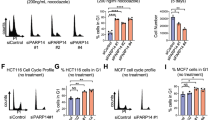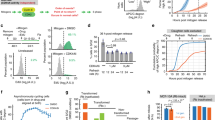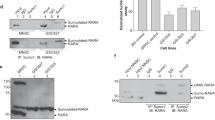Abstract
Development of human neuroblastoma is due to an arrest in the differentiation program of neural crest sympathoadrenal progenitor cells. However, neuroblastomas, as well as their derived cell lines, maintain the potentiality of terminal differentiation. We investigated the molecular mechanisms by which retinoic acid, a molecule introduced in clinical trials for chemotherapy, induces differentiation in neuroblastoma cell lines. Our findings demonstrate that the retinoic acid-dependent growth arrest of LAN-5 neuroblastoma cell line is associated to a very large accumulation (>tenfold) of p27Kip1 protein, a cyclin-dependent kinase inhibitor; the protein binds and inhibits cyclin-dependent kinase 2, 4 and 6 activities, thus hampering pRb and p107 phosphorylation. p27Kip1 build-up was observable as an early phenomenon (12–24 h) after retinoic exposure and resulted in a time-dependent accumulation of high quantities of a free p27Kip1 form. Furthermore, retinoic treatment causes an increase of cyclin-dependent kinase 5 level and activity; however, immunoprecipitation studies proved the absence of interaction with p27kip1. No noticeable variation of other components of G1 phase cell cycle engine was observed. Pulse-chase experiments showed a remarkable elongation of p27Kip1 half-life in retinoic-treated LAN-5, while no enhancement of p27Kip1 gene expression and of the translational efficiency of its messenger RNA were demonstrated. In vivo degradation of p27Kip1 was sensitive to two highly specific proteasome inhibitors, LLnL and lactacystin, while the calpain inhibitor II ALLM and the cysteine protease inhibitor E64 did not modify the level of the protein. LLnL treatment caused a very rapid (2 h) build-up of the Cdk inhibitor content and the accumulation of higher molecular weight anti-p27Kip1 immunoreactive bands, which probably represent ubiquitinated forms of the protein. Finally, in vitro experiments demonstrated that extracts prepared from retinoic-treated LAN-5 cells degraded recombinant p27Kip1 at a rate remarkably slower than the untreated cells. Our results indicate that retinoic acid strongly increases p27Kip1 levels by down-regulating the ubiquitin-proteasome p27Kip1 degrading pathway.
This is a preview of subscription content, access via your institution
Access options
Subscribe to this journal
Receive 50 print issues and online access
$259.00 per year
only $5.18 per issue
Buy this article
- Purchase on Springer Link
- Instant access to full article PDF
Prices may be subject to local taxes which are calculated during checkout








Similar content being viewed by others
References
Alessandrini A, Chiaur DS and Pagano M . 1997 Leukemia 11: 342–347.
Chomczynski P and Sacchi N . 1987 Analytical Biochem 162: 156–159.
Coats S, Flanagan WM, Nourse J and Roberts JM . 1996 Science 272: 877–880.
Della Ragione F, Russo GL, Oliva A, Mastropietro S, Mancini A, Borrelli A, Casero RA, Iolascon A and Zappia V . 1995 Oncogene 10: 827–835.
Della Ragione F, Russo GL, Oliva A, Mercurio C, Mastropietro S, Della Pietra V and Zappia V . 1996 J Biol Chem 271: 15942–15949.
Dongming S, Leung CL and Liem RKH . 1996 J Biol Chem 271: 14245–14251.
Dulic V, Kaufmmann WK, Wilson AJ, Tlsty TD, Lees E, Harper JW, Elledge SJ and Reed SI . 1994 Cell 76: 1013–1023.
El-Deiry WS, Tokino T, Velculescu VE, Levy DB, Parsons R, Trent JM, Lin D, Mercer WE, Kinzler KW and Vogelstein B . 1993 Cell 75: 815–825.
Elledge SJ, Winson J and Harper JW . 1996 Trends Cell Biol 6: 388–392.
Harper JW, Adami GR, Wei N, Keyomarsi K and Elledge S . 1993 Cell 75: 805–816.
Hengst L, Dulic V, Slingerland JM, Lees E and Reed SI . 1994 Proc Natl Acad Sci USA 91: 5291–5295.
Hengst L and Reed SI . 1996 Science 271: 1861–1864.
Iolascon A, Giordani L, Moretti A, Tonini GP, Lo Cunsolo C, Mastropietro S, Borriello A and Della Ragione F . 1998 Pediatric Res 43: 139–144.
Kato JY, Matsuoka M, Polyak K, Massague J and Sherr CJ . 1994 Cell 79: 487–496.
Khan AA, Villablanca JG, Reynolds CP and Avramis VI . 1996 Cancer Chemo Pharmacol 39: 34–41.
Lee M-H, Reynisdottir I and Massague J . 1995 Genes Dev 9: 639–649.
Liu M, Lee M-H, Cohen M, Bommakanti M and Freedman LP . 1996 Genes Dev 10: 142–153.
Loda M, Cukor B, Tam SW, Lavin P, Fiorentino M, Draetta GF, Jessup JM and Pagano M . 1997 Nature Med 3: 231–236.
Murakami T, Ohmori H, Tsuda T and Higashi K . 1991 Progr Clin Biol Res 366: 65–70.
Nicoletti I, Migliorati G, Pagliacci MC, Grignai F and Riccardi C . 1991 J Immunol Met 139: 271–279.
Pagano M, Tam SW, Theodoras AM, Beer RP, Del SG, Chau V, Yew PR, Draetta GF and Rolfe M . 1995 Science 269: 682–685.
Philip T and Pinkerton CR . 1989 In New Direction in Cancer Treatment Magrath J ed Springer Heidelberg Germany pp 605–611
Pinkerton CR . 1993 In Human Neuroblastoma Recent Advances in Clinical and Genetics Analysis Schwab M, Tonini GP and Benard J eds. Harwood Academic Publications Chur, Switzerland pp 3–10
Polyak K, Kato JY, Solomon MJ, Sherr CJ, Massague J, Roberts JM and Koff A . 1994b Genes Dev 8: 9–22.
Sheaff RJ, Groudine M, Gordon M, Roberts JM and Clurman BE . 1997 Genes Dev 11: 1464–1470.
Sherr CJ . 1994 Cell 79: 551–555.
Thiele CJ, Reynolds CP and Israel MA . 1985 Nature 313: 404–406.
Timchenko NA, Wilde N, Nakanishi M, Smith JR and Darlington GJ . 1996 Genes Dev 10: 804–815.
Toyoshima H and Hunter T . 1994 Cell 78: 67–74.
Vlach J, Hennecke S, Alevizopoulos K, Conti D and Amati B . 1996 EMBO J 15: 6595–6604.
Vlach J, Hennecke S and Amati B . 1997 EMBO J 16: 5334–5344.
Zancai P, Cariati R, Rizzo S, Baiocchi M and Dolcetti R . 1998 Oncogene 17: 1827-1836
Acknowledgements
We thank Dr M Pagano for the p27Kip1 expression vector. The authors are grateful to Mr Massimo Brunone for his expert assistance. We wish to also thank the Associazione Italiana per la Lotta al Neuroblastoma. This work was supported in part by the Associazione Italiana per la Ricerca sul Cancro (AIRC) grant (to F Della Ragione) and by MURST grants (to F D Ragione and A Iolascon).
Author information
Authors and Affiliations
Rights and permissions
About this article
Cite this article
Borriello, A., Pietra, V., Criscuolo, M. et al. p27Kip1 accumulation is associated with retinoic-induced neuroblastoma differentiation: evidence of a decreased proteasome-dependent degradation. Oncogene 19, 51–60 (2000). https://doi.org/10.1038/sj.onc.1203231
Received:
Revised:
Accepted:
Published:
Issue Date:
DOI: https://doi.org/10.1038/sj.onc.1203231
Keywords
This article is cited by
-
CDK inhibitors reduce cell proliferation and reverse hypoxia-induced metastasis of neuroblastoma tumours in a chick embryo model
Scientific Reports (2019)
-
A novel RING finger protein, Znf179, modulates cell cycle exit and neuronal differentiation of P19 embryonal carcinoma cells
Cell Death & Differentiation (2011)
-
Rb2/p130 and protein phosphatase 2A: key mediators of ovarian carcinoma cell growth suppression by all-trans retinoic acid
Oncogene (2006)
-
Estrogen-Induced Proliferation in Cultured Hepatocytes Involves Cyclin D1, P21CIP1 and P27KIP1
Digestive Diseases and Sciences (2006)
-
RARγ acts as a tumor suppressor in mouse keratinocytes
Oncogene (2004)



